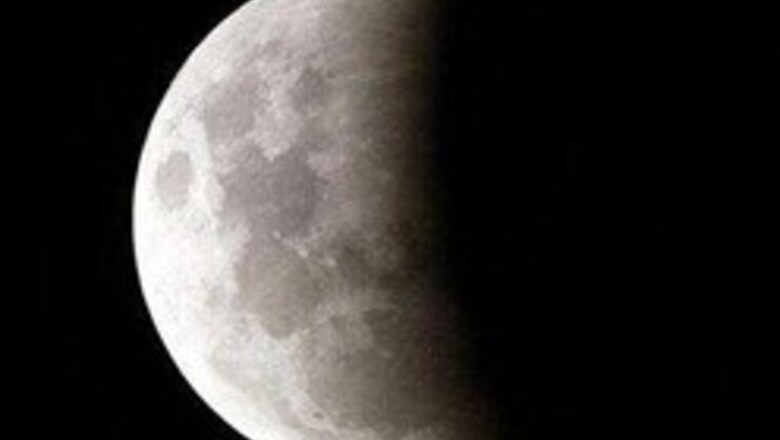
views
Bangalore: India's space scientists and technologists will hold a brain-storming session here Tuesday to explore the viability of undertaking a manned mission to the moon by the end of the next decade (2020).
With President APJ Abdul Kalam rooting for such an adventure, about 50-60 experts from top research labs and scientific institutions will get a preview of the ambitious project conceived by the Indian Space Research Organisation (ISRO) that is planning to send an Indian astronaut into space on a indigenous space capsule by 2014.
"We have already made a presentation to the prime minister last month (Oct 17) on our capabilities to launch a manned mission into space by 2014.
As preparations to launch an unmanned lunar mission (Chandrayaan-1) by 2008 are under way, we will be exploring the prospects of landing an Indian on moon by at least 2020," a top ISRO official said.
At the meeting, ISRO chairman G Madhavan Nair will make a detailed presentation on the pros and cons of launching a manned mission to the moon, the benefits that are expected to accrue from such a mission and the resources required to undertake it.
"We have invited the heads of various research and development (R&D) organisations, including the Indian Institute of Astrophysics, Indian Institute of Science, National Aerospace Laboratories and the department of science & technology to ascertain their views on the project and draw a road map for embarking on such a mission," the official said.
Based on the deliberations and feedback from the experts, ISRO plans to prepare a project report for government approval and budgetary allocation in the 11th and 12th five-year plans.
Prime Minister's Science Advisory Council chairman C N R Rao and former ISRO chairmen K Kasturirangan and U R Rao have also been invited to participate in the daylong session and present their views on the multibillion rupee project.
"Though we have the capabilities and resources to undertake such a mission, we need to cover a lot of ground to assess its viability in terms of the prohibitive cost, materials and manpower involved. The issue is not whether we can do, but at what cost and how the country would benefit from it," U R Rao said.
PAGE_BREAK
ISRO sources admit a manned mission to the moon would cost the nation a whopping Rs 200 billion, while a manned mission into space would require about Rs 150 billion over a seven-year period.
"The funds will be required to build the facilities, new technologies and training hundreds of scientists and engineers to execute the project. A host of R&D organisations such as the Institute of Aerospace Medicine and Defence Food Research Laboratory will have to be involved for preparing the astronaut(s) to survive in zero-gravity condition," a ISRO scientist pointed out.
The space agency is also toying with the idea of coining a Sanskrit name to be used for Indian astronauts who will be launched into space and on the moon subsequently.
Ironically, the annual budget for ISRO is currently pegged at Rs. 36 billion (2006-07).
It has earmarked about Rs 3.86 billion for Chandrayaan-1, slated for launch in 2008, to conduct experiments on the moon surface with its spacecraft in the lunar orbit.
In the run-up to undertaking such ambitious missions, ISRO is working on a three-tonne space capsule with life support systems and allied facilities for two people onboard. The capsule will be launched using an upgraded version of the Geosynchronous Satellite Launch Vehicle (GSLV-MK-II) from the Satish Dhawan Space Centre at Sriharikota in Andhra Pradesh in 2007.
The four-tonne class rocket will place the space capsule into an orbit at a height of 400 km from earth about 16 minutes after lift-off. The capsule is expected to orbit initially for a day and in subsequent launches for a week before returning for a splashdown in the Bay of Bengal.
"The voyage to moon will be of longer duration with the capsule taking at least five days to reach the destination after the launch and another five days for the return trip," the official disclosed.
The trials for the manned space missions will be taken up next year with the 600-kg Space Capsule Recovery (SRE) experiment, to be launched using the Polar Satellite Launch Vehicle (PSLV) rocket.
The module will orbit the earth for a week and splash down in the Bay of Bengal. A number of cutting-edge technologies required for an Indian journey into space will be validated during these tests.
"A successful manned mission to moon will give India the status of a super-power with technological capability on par with the United States, Russia, European Space Agency (ESA), China (in manned mission to space), development of new types of materials and breakthrough in medicine and life sciences, communications," the official added.
According to Indian Space Commission member Roddam Narasimha, who is one of the invitees for the meeting, a manned mission to moon would make India a force to reckon with and count among the select few countries in the space club.
"India should have a major presence in space. If we make up our mind, we will acquire the know-how. We should certainly put more effort into research missions now. So far, our emphasis was on development of satellites (for communications and remote sensing) and rockets," Narasimha said.
Within ISRO, however, a few scientists have told Nair a robotic mission into space would suffice rather than an Indian undertaking the voyage in space.
"There are some within our organisation saying a manned mission is not required and a robot or instruments can do the job. I subscribe to the view that no robot or instrument can substitute the human brain when it comes to decision-making," Nair has been quoted telling the scientists having reservations about landing an Indian on moon.


















Comments
0 comment